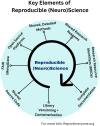Editorial: Reproducibility in neuroscience
- PMID: 37727652
- PMCID: PMC10505729
- DOI: 10.3389/fnint.2023.1271818
Editorial: Reproducibility in neuroscience
Keywords: FAIR (findable accessible interoperable and reusable) principles; replicability; replication studies; research integrity; rigor and quality.
Conflict of interest statement
The authors declare that the research was conducted in the absence of any commercial or financial relationships that could be construed as a potential conflict of interest. The author(s) declared that they were an editorial board member of Frontiers, at the time of submission. This had no impact on the peer review process and the final decision.
Figures

Comment on
- Editorial on the Research Topic Reproducibility in neuroscience
References
Publication types
LinkOut - more resources
Full Text Sources

